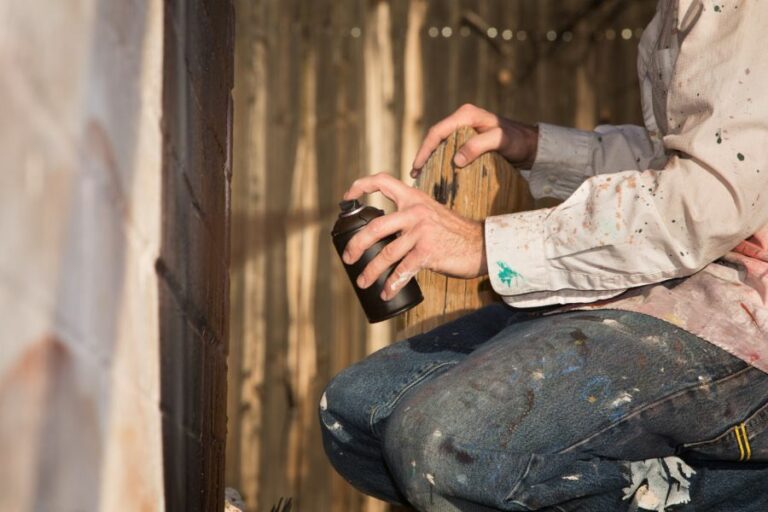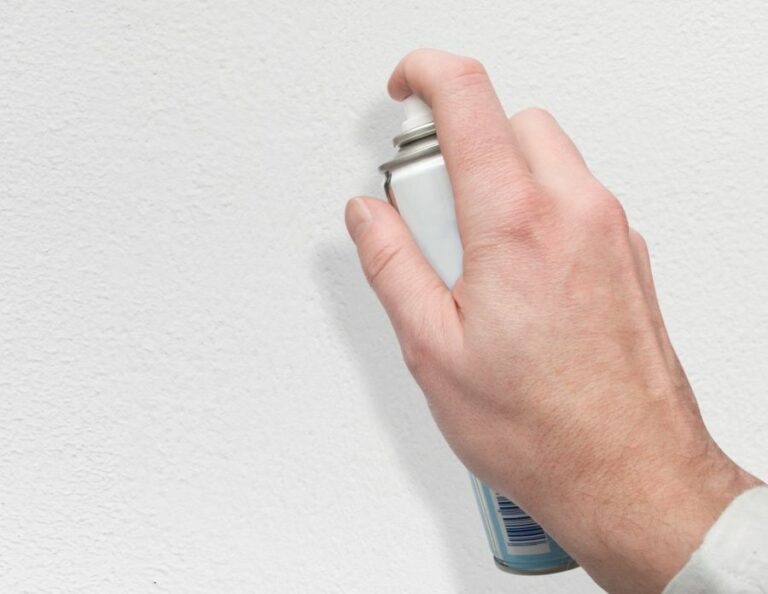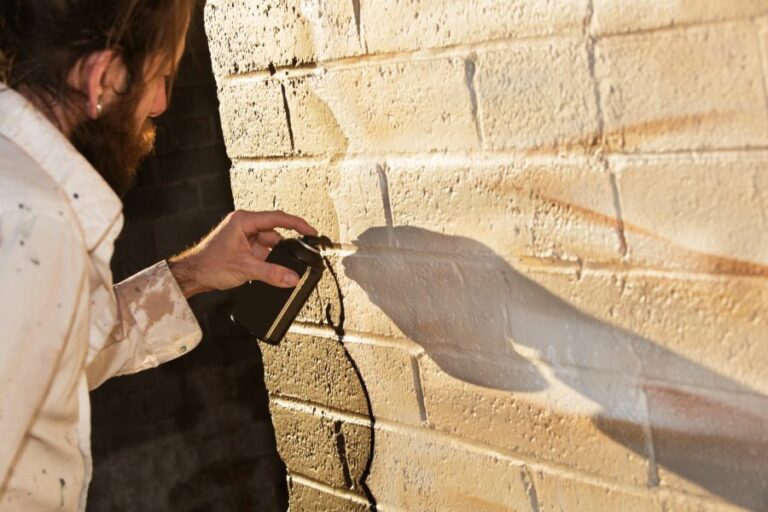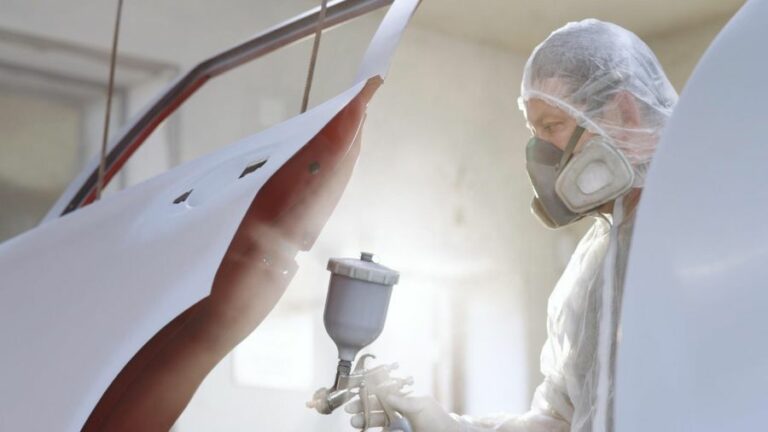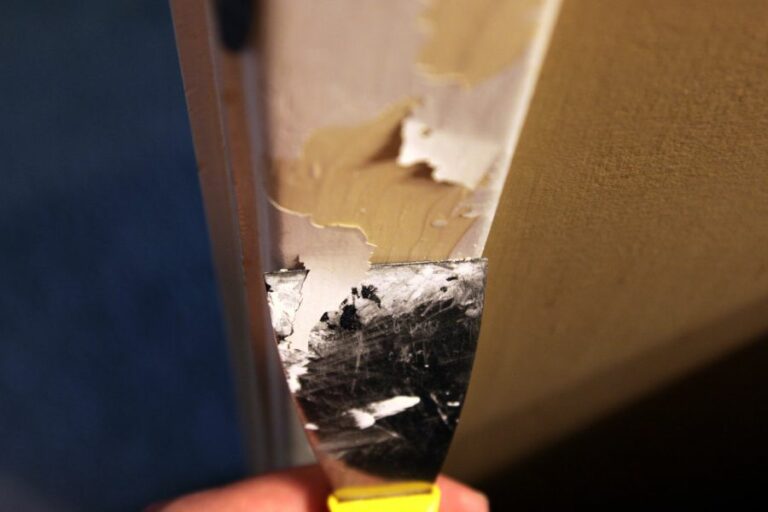DIY Guide: Removing Spray Paint Surfaces, What Pros Say
Are you struggling with stubborn spray paint on surfaces that you can’t seem to remove? Don’t worry – we’ve got you covered! In our comprehensive DIY guide, we’ll walk you through all the best techniques and methods for effectively removing spray paint from various surfaces. With our easy-to-follow instructions, you’ll be able to confidently tackle even the toughest paint removal jobs and achieve pristine results.
Diy guide: removing spray paint surfaces:
To remove spray paint from surfaces, use paint thinner or acetone on metal, chemical paint stripper on wood, razor blades and rubbing alcohol on the glass, and trisodium phosphate (TSP) or commercial cleaner on concrete. Follow appropriate steps for each surface, including applying the chosen cleaner, scraping or scrubbing the paint, and rinsing the surface. Always wear protective gear and work in well-ventilated spaces.

Ready to tackle that unwanted graffiti or spray paint? We’ve got you covered! Our DIY guide will walk you through the essential tips and tricks to remove spray paint from various surfaces. Keep reading to restore your space back to its original glory!
Contents
- 1 Comprehensive Guide: Eliminating Spray Paint from Surfaces
- 2 Top Techniques for Clearing Spray Paint Residue
- 3 Efficient Ways to Clean Spray Paint off Surfaces
- 4 Removing Rustoleum Spray Paint from Plastic Safely
- 5 Is Hydrogen Peroxide Effective for Spray Paint Removal?
Comprehensive Guide: Eliminating Spray Paint from Surfaces
Spray paint is a versatile and convenient tool for updating various surfaces – from furniture to vehicles. However, accidentally applying it to unwanted areas or removing it for a new project may be challenging.
• Removing Spray Paint from Metal
– Gather Tools and Materials
- Paint thinner, acetone, or lacquer thinner
- Soft cloth or sponge
- Steel wool or abrasive pad
- Protective gloves
- Safety glasses
- Paintbrush
Before starting, ensure proper protection, including gloves and eyewear. Also, work in a well-ventilated space to avoid inhaling harmful chemicals.
– Step 1: Apply Paint Thinner
Apply paint thinner to a soft cloth or sponge to dampen, but not soaking wet. Gently rub the spray paint-covered metal surface in a circular motion, reapplying thinner as necessary. This process will slowly loosen and break down the paint.
If paint remains, use a stronger solvent like acetone or lacquer thinner, taking care to avoid inhaling their fumes.
– Step 2: Scrape the Paint
Use a paintbrush to gently scrape away the softened paint. If stubborn spots remain, use steel wool or an abrasive pad, but avoid damaging the underlying metal.
– Step 3: Clean the Surface
Once the paint is removed, clean the metal surface using a fresh cloth and paint thinner. Rinse with water and let it dry.
• Removing Spray Paint from Wood
– Gather Tools and Materials
- Chemical paint stripper (liquid or gel)
- Plastic scraper
- Brush or sponge
- Steel wool or abrasive pad
- Bucket of warm soapy water
- Protective gloves
- Safety glasses
Always wear gloves and safety glasses while handling chemicals and follow the instructions provided by the paint stripper manufacturer.
– Step 1: Apply the Stripper
Apply a generous amount of paint stripper to the spray paint-covered wood surface using a brush or sponge. You may need to apply multiple layers to penetrate thick paint coatings. Allow the stripper to sit for the recommended time listed on the product label.
– Step 2: Scrape the Paint
After the stripper has loosened the paint, use a plastic scraper to remove it carefully. Avoid using a metal scraper, as it may damage the wood. If any paint remains, scrub with steel wool or an abrasive pad.
– Step 3: Clean the Surface
Clean the wood surface with warm soapy water to remove any remaining stripper residue. Rinse with clean water and let it dry thoroughly.
• Removing Spray Paint from Glass
– Gather Tools and Materials
- Razor blade
- Rubbing alcohol or acetone
- Soft cloth or paper towels
- Protective gloves
- Safety glasses
When working with sharp tools, protective eyewear and gloves are essential to reduce the risk of injury.
– Step 1: Scrape the Paint
Use a razor blade to gently scrape the spray paint off the glass surface. Keep the blade as flat as possible relative to the glass to prevent scratches. Be patient and take your time during this step.
– Step 2: Clean the Surface
Apply rubbing alcohol or acetone to a soft cloth or paper towel to remove any remaining paint residue. For final cleaning, use window cleaner or a vinegar-and-water solution.
Ensure the glass is free of streaks by wiping it down with a dry, lint-free cloth or crumpled newspaper.
• Removing Spray Paint from Concrete
– Gather Tools and Materials
- TSP (trisodium phosphate) or a commercial concrete cleaner
- Stiff-bristled brush
- Power washer (optional)
- Protective gloves
- Safety glasses
Working with strong chemicals like TSP requires proper protection, including gloves and safety glasses.
– Step 1: Apply the Cleaner
Wet the concrete surface, then apply the TSP or concrete cleaner following the manufacturer’s instructions. TSP must be mixed with water to create a cleaning solution, while commercial concrete cleaners may be used directly.
– Step 2: Scrub the Paint
Scrub the paint-covered area vigorously with a stiff-bristled brush. The paint should begin to break down and lift from the concrete surface.
– Step 3: Rinse the Surface
Using a power washer or hose with a high-pressure nozzle, rinse the concrete thoroughly. Any remaining paint should wash away. Though not required, a power washer can simplify this process significantly.
In conclusion, this guide has covered various surfaces and methods to remove spray paint. Remember to take necessary safety precautions and work in well-ventilated spaces when handling chemicals.
For more information on paint removal, visit the Environmental Protection Agency’s guidelines on safe paint removal practices.
Top Techniques for Clearing Spray Paint Residue
Spray paint is an effective and convenient way to apply paint to various surfaces. However, it is also susceptible to overspray, leading to unsightly paint residue on unintended areas.
• Methods for Removing Spray Paint Residue
1. Rubbing Alcohol
Rubbing alcohol, also known as isopropyl alcohol, is an effective way to remove wet or dry spray paint residue.
A study from Iowa State University highlights the efficacy of isopropyl alcohol as a cleaning agent, which makes it suitable for paint removal. To remove spray paint residue using isopropyl alcohol, follow these steps:
- Wet a cloth with the alcohol.
- Gently rub the affected area in a circular motion.
- Repeat the process until the spray paint is completely removed.
- Clean the area with soap and water, then dry it with a clean cloth.
2. Nail Polish Remover
Nail polish remover, specifically the kind containing acetone, is another effective method for removing spray paint residue
. However, it is important to test the surface for compatibility before using this method, as acetone can damage certain plastics and finishes. To remove spray paint residue with nail polish remover, follow these steps:
- Apply a small amount of nail polish remover to a cotton ball or cloth.
- Gently dab the affected area, being careful not to spread the residue further.
- Continue dabbing until the spray paint is removed.
- Clean the area with soap and water, then dry it with a clean cloth.
3. Paint Thinner
Paint thinner is a strong solution used to clean and remove paint. It is readily available at hardware stores and can effectively remove spray paint residue, especially from nonporous surfaces like metal and glass. To remove spray paint residue with paint thinner, follow these steps:
- Apply a small amount of paint thinner to a cloth.
- Gently rub the affected area, making sure to keep the cloth on the residue and not spread it to unaffected areas.
- Continue rubbing until the spray paint is removed.
- Clean the area with soap and water, then dry it with a clean cloth.
4. Graffiti Removal Products
There are commercial products specifically designed for removing spray paint residue and graffiti. These can be found online or in hardware stores and usually come in gel or liquid form. Make sure to follow the instructions on the packaging when using these products. Typically, the process involves:
- Applying the product to the affected area.
- Letting it sit for a specified amount of time.
- Scrubbing the area with a brush or cloth.
- Rinsing with water and drying with a clean cloth.
5. Scraping and Sanding
For more stubborn spray paint residue, scraping and sanding may be necessary. This method is highly effective for surfaces like wood and metal, where the finish is less likely to be damaged. When doing this:
- Scrape the residue using a plastic scraper, being careful not to damage the surface.
- Sand the area with fine-grit sandpaper or sanding block.
- Repeat scraping and sanding until the surface is smooth and free of residue.
- Clean the area with a damp cloth to remove any dust and debris.
• Tips for Effectively Removing Spray Paint Residue
- Always test a small, inconspicuous area before using any of the methods mentioned above. This will help to ensure that the chosen method will not damage the surface.
- Be patient and persistent. Removing spray paint residue can be a time-consuming process, and it is important to persevere and not resort to more abrasive methods, which can damage the surface.
- Wear proper safety equipment, such as gloves and safety goggles, when using chemicals and tools to remove spray paint residue.
- Be cautious when using scraping and sanding methods on delicate surfaces, as they may cause damage.
• Importance of Safety Precautions
It is crucial to prioritize safety when removing spray paint residue, especially when working with chemicals and tools.
The use of gloves, safety goggles, and proper ventilation can significantly reduce the risk of injury or exposure to harmful fumes. Additionally, it is important to properly dispose of any chemicals or materials used in the process, following the guidelines provided by the product manufacturers and local regulations.
In conclusion, removing spray paint residue can be an arduous task, but using the right methods and following safety precautions can significantly simplify it.
Whether you choose to use rubbing alcohol, nail polish remover, paint thinner, commercial graffiti removal products, or scraping and sanding, always test the surface first and prioritize safety during the process.
By doing so, you can effectively remove spray paint residue without causing damage to the surface or putting yourself at risk.
Method | Description |
|---|---|
Soap and water | Use a mild detergent and warm water to scrub the residue gently with a sponge or cloth. |
Acetone | Apply acetone to a cloth or sponge and gently rub the residue until it comes off. Make sure to wear gloves and work in a well-ventilated area. |
Paint thinner | Apply paint thinner to a cloth or sponge and gently rub the residue until it comes off. Remember to wear gloves and work in a well-ventilated area. |
Graffiti remover | Use a commercial graffiti remover according to the manufacturer’s instructions. Apply the remover to the residue and follow the recommended waiting time before wiping or rinsing off. |
WD-40 | Spray WD-40 on the spray paint residue and let it sit for a few minutes. Then, scrub the area with a cloth or sponge until the residue comes off. |
Efficient Ways to Clean Spray Paint off Surfaces
Spray paint can be a nuisance when it ends up on surfaces where it doesn’t belong. Whether you’re dealing with home improvement projects gone awry or graffiti, learning how to remove spray paint from a variety of surfaces is essential.
• Removing Spray Paint from Concrete
Concrete is porous, which means that it can absorb spray paint, making it tricky to remove. However, by following these steps, you can get rid of the unwanted paint effectively:
- Start by sweeping the area to remove dirt and debris.
- Pour a generous amount of graffiti remover or paint stripper onto the affected area. The City of Seattle recommends using a water-based or biodegradable product.
- Allow the remover to sit on the surface for 10-15 minutes or as instructed on the product label.
- Use a stiff-bristled brush to scrub the paint away, applying pressure as needed.
- Rinse the area thoroughly with water, using a pressure washer if available.
Tip: Consider applying a concrete sealer after cleaning the area to protect it from future paint stains.
• Removing Spray Paint from Metal
Metal surfaces require careful consideration when removing spray paint to avoid damage or unwanted scratches. Follow these steps to tackle spray paint on metal:
- Apply a small amount of rubbing alcohol, acetone, or nail polish remover to a clean cloth.
- Gently rub the cloth on the affected area, applying more of the chosen solvent if needed.
- For stubborn paint, use a plastic scraper or an old credit card to gently scrape the paint off the surface.
- Once the paint is removed, clean the area with warm, soapy water and let it dry completely.
Tip: To prevent scratching the metal surface, avoid using abrasive materials or metal scrapers.
• Removing Spray Paint from Plastic
Plastic surfaces can be sensitive to harsh chemicals, and it’s important to take extra care when removing spray paint from them. Here’s a safe and effective approach:
- Test a small, inconspicuous area with rubbing alcohol or acetone to ensure it will not damage the plastic.
- Assuming it’s safe, apply the solvent to a clean cloth and gently rub the affected area in a circular motion.
- If the paint is stubborn, use a delicate abrasive pad, like a melamine sponge (e.g., Magic Eraser), to gently scrub the paint away.
- Rinse the surface with warm water and mild soap to remove any residue.
Tip: It’s essential to test an inconspicuous area before using the solvent on the plastic, as some plastics may become damaged or discolored.
• Removing Spray Paint from Glass
Glass surfaces require a delicate approach when removing spray paint to avoid scratching or causing permanent damage. Follow these simple steps to address spray paint on glass:
- Apply window cleaner or rubbing alcohol to a microfiber cloth.
- Gently rub the cloth on the affected area, reapplying the window cleaner or rubbing alcohol as needed.
- For stubborn paint, use a razor blade or plastic scraper and carefully scrape the paint off the surface, holding the blade at a 45-degree angle.
- Clean the area with warm, soapy water or a glass cleaner, and let it dry completely.
Tip: To avoid scratching the glass, always use a new razor blade and ensure it is free of rust or debris.
• Removing Spray Paint from Wood
Removing spray paint from wood can be challenging, as the paint may soak into the porous surface. However, the following steps can help ensure a successful removal process:
- Use 120-grit sandpaper to gently sand the affected area, taking care not to damage the wood beneath the paint.
- Wipe away the dust with a clean cloth or tack cloth.
- Apply a chemical paint remover on the paint, following the product’s instructions for the proper application method and waiting time.
- Gently remove the loosened paint with a plastic scraper or an old credit card.
- Follow up with a finer 220-grit sandpaper to smooth the surface.
- Finish by wiping the area with a clean cloth and applying a wood finish or paint as desired.
Tip: When sanding, be sure to follow the grain of the wood to avoid leaving scratches or gouges.
In conclusion, the key to removing spray paint from various surfaces is understanding the material’s properties and applying the appropriate technique accordingly.
By following the specific steps outlined in this article, you can safely and effectively eliminate spray paint from a wide range of surfaces. Remember to always test an inconspicuous area with any chemicals or solvents to prevent potential damage to the material.
Surface | Removal Method |
|---|---|
Wood | Sand the affected area lightly, then apply a paint thinner or mineral spirits with a clean cloth. |
Metal | Use a paint thinner or solvent like acetone with a clean cloth. Gently scrub the affected area until the paint is removed. |
Plastic | Apply a non-acetone-based nail polish remover or rubbing alcohol on a clean cloth and gently rub the painted area until it’s removed. Be cautious not to damage the plastic. |
Glass | Use a razor blade to gently scrape off the paint, or apply a paint thinner with a clean cloth. |
Concrete | Apply a paint stripper or graffiti remover, let it sit for about 30 minutes, then scrub the area with a stiff-bristle brush. Rinse with water. |
Removing Rustoleum Spray Paint from Plastic Safely
Rustoleum spray paint is known for its durability and ability to adhere well to various surfaces. However, there might be instances when you need to remove the paint from a plastic surface, either due to an accidental overspray or a change in plans.
• Safety First
Before we dive into the various methods for removing Rustoleum spray paint from plastic, it’s essential to address safety.
When working with chemicals or solvents, be sure to work in a well-ventilated area, wear gloves, and protect your eyes with safety goggles. Additionally, always read and follow the instructions on any product you use.
• Method 1: Soap and Water
Sometimes, simple solutions are the best. If the paint is still fresh or hasn’t adhered well to the plastic surface, you might be able to remove it using soap and water.
- Mix a few drops of dish soap with warm water in a bucket or container.
- Dip a sponge or cloth into the soapy water and gently scrub the plastic surface to remove the paint.
- Rinse the sponge or cloth frequently and refresh the soapy water if needed.
- Once the paint is removed, rinse the plastic surface with clean water and allow it to dry.
• Method 2: Isopropyl Alcohol
If soap and water don’t do the trick, you can try using isopropyl alcohol (also known as rubbing alcohol) to remove the paint.
- Moisten a cotton ball or cloth with isopropyl alcohol.
- Gently rub the affected area in a circular motion, applying only enough pressure to remove the paint.
- Be patient and give the isopropyl alcohol time to work. It may take several applications to break down the paint.
- Once the paint is removed, rinse the plastic surface with clean water and allow it to dry.
Tip: Isopropyl alcohol tends to evaporate quickly, so you might need to reapply it to your cotton ball or cloth frequently.
• Method 3: Paint Thinner
Paint thinner, such as mineral spirits or acetone, can also be effective in removing Rustoleum spray paint from plastic. However, it’s essential to test a small, inconspicuous area of the plastic surface first to ensure it won’t be damaged by the paint thinner.
- Moisten a cloth with paint thinner and gently rub the painted area in a circular motion.
- Allow the paint thinner to sit on the surface for a few minutes to break down the paint.
- Wipe away the loosened paint with a clean cloth or sponge.
- Repeat the process as necessary until the paint is removed.
- Once the paint is gone, rinse the surface with clean water and allow it to dry.
Note: Some types of plastics may be sensitive to paint thinner, so be cautious and test a small area first.
• Method 4: Plastic Razor Blade or Scraper
In some cases, you may be able to remove the paint by gently scraping it off the plastic surface. A plastic razor blade or scraper is designed not to damage the underlying surface while effectively removing paint or other residues.
- Hold the plastic razor blade or scraper at a 45-degree angle to the surface.
- Apply gentle pressure and work in small strokes to lift the paint away.
- Be patient and avoid using excessive pressure, as this may damage the plastic.
- Clean the blade frequently to remove any paint residue.
- Once the paint is removed, rinse the surface with clean water and allow it to dry.
• Precautions and Additional Tips
- Always test a small, inconspicuous area of the plastic surface before using any chemical, solvent, or abrasive method. This will help you avoid causing further damage to your items.
- Be patient and persistent. Removing Rustoleum spray paint from the plastic can take time and several attempts before the paint is entirely gone.
- Consider your plastic surface’s composition and age, as some materials will be more susceptible to damage than others. Older plastics are more likely to become brittle, while some plastics may react poorly to chemicals.
• Conclusion
Although removing Rustoleum spray paint from the plastic can be challenging, using the appropriate methods and precautions can make the process more manageable. Always prioritize safety and test a small area of your surface before proceeding.
With patience and the right approach, you can successfully remove Rustoleum paint from plastic surfaces and restore your items to their original state.
For more information on paint removal and related techniques, consider visiting the website of the Paint and Decorating Retailers Association (.org) or your local government’s consumer protection agency (.gov).
Step | Description |
|---|---|
1 | Test a small, inconspicuous area to ensure it will not damage the plastic. |
2 | Apply a paint remover, rubbing alcohol, or acetone to a cloth or rag. |
3 | Gently rub the cloth or rag with the remover on the painted surface, applying more as needed. |
4 | Allow the remover to sit for a few minutes as it works to break down the paint. |
5 | Use a plastic scraper or your fingernail to carefully scrape off the loosened paint. |
6 | Rinse the area with water to remove any remaining paint and cleaner residue. |
7 | Wipe the surface dry with a clean cloth, and repeat the process if any paint remains. |
Is Hydrogen Peroxide Effective for Spray Paint Removal?
Spray paint is a popular medium for both artists and DIY enthusiasts alike. But what happens when you accidentally spray paint a surface that you did not intend to?
• The Science Behind Hydrogen Peroxide
Hydrogen peroxide, known chemically as HO, is a powerful oxidizing agent that makes it useful for various household purposes.
This includes cleaning, disinfection, and stain removal. The substance’s reactive nature causes it to break down various other compounds, making it an ideal candidate for paint removal tasks.
It is important to keep in mind that hydrogen peroxide comes in different concentrations, with the most common ones available for household use being 3% and 6%. The concentration levels affect its potency and, thus, its effectiveness on different paints and surfaces.
• Hydrogen Peroxide for Removing Spray Paint
In many cases, hydrogen peroxide effectively removes spray paint from various surfaces. However, its effectiveness depends on factors such as the surface type, the paint’s age, and the concentration of the hydrogen peroxide solution used.
Here are some surfaces on which hydrogen peroxide can be used to remove spray paint:
– Glass and Ceramic Surfaces
Hydrogen peroxide works well in removing spray paint from glass and ceramic surfaces. It can dissolve the paint without causing scratches or damage, unlike abrasive methods such as sandpaper or steel wool.
For effective paint removal from these surfaces, apply a generous amount of hydrogen peroxide on the painted area, let it sit for a few minutes, and wipe it off with a cloth or sponge.
– Metal Surfaces
Hydrogen peroxide can also be useful for spray paint removal from metal surfaces. However, the reaction time may be longer than that with glass or ceramic surfaces.
Apply the hydrogen peroxide solution on the affected area, let it sit for an extended period, and then scrub it off using a sponge or a soft-bristled brush. Be cautious, though, as hydrogen peroxide can corrode certain metals, leading to rust or discoloration.
A compatibility test on a small hidden area is recommended before applying the solution on the entire surface.
– Fabric and Upholstery
Using hydrogen peroxide on fabrics and upholstery might be helpful for spray paint removal, but it requires caution. Hydrogen peroxide can bleach colored fabrics and weaken fibers, potentially leading to more damage than the initial paint stain.
Before applying hydrogen peroxide on these surfaces, test it on a small, inconspicuous area to ensure it does not cause any bleaching effect or material deterioration.
• Limitations and Alternatives
While hydrogen peroxide can be effective in removing spray paint, there are limitations to its use:
- Not suitable for all surfaces: Hydrogen peroxide may not work well on porous surfaces like wood, as the paint seeps deep into the material, making it difficult to remove.
- Potential for surface damage: High concentrations or extended exposure to hydrogen peroxide can cause harm to certain surfaces, such as discoloration or corrosion.
In some instances, alternative methods like using acetone, paint removers, or graffiti removal wipes might yield better results. It is essential to research and test various methods in small areas to find the most suitable approach for your spray paint removal needs.
• Safety Precautions
When using hydrogen peroxide, follow proper safety guidelines to prevent accidents or injuries:
- Always wear gloves and protective eyewear when handling hydrogen peroxide.
- Use the solution in a well-ventilated area to minimize the risk of inhalation of fumes.
- Avoid contact with skin, eyes, and clothing, as hydrogen peroxide can be irritating and cause damage.
- Store hydrogen peroxide away from heat sources, direct sunlight, and flammable materials.
For further information on hydrogen peroxide safety and handling, consult resources from reputable sources, such as the United States Environmental Protection Agency (EPA).
• Conclusion
Overall, hydrogen peroxide can be an effective solution for removing spray paint from certain surfaces, such as glass, ceramic, and metal. However, its effectiveness depends on various factors, and it is crucial to test it on small areas to ensure compatibility and avoid potential damage.
Also, take proper safety precautions when handling hydrogen peroxide to ensure a risk-free paint removal process.


